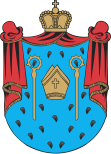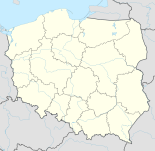Ujest municipality
| Ujest Gmina Ujazd municipality |
||
|---|---|---|

|
|
|
| Basic data | ||
| State : | Poland | |
| Voivodeship : | Opole | |
| Powiat : | Strzelecki | |
| Geographic location : | 50 ° 24 ' N , 18 ° 21' E | |
| Height : | 208 m npm | |
| Residents : | s. Gmina | |
| Postal code : | 47-143 | |
| Telephone code : | (+48) 77 | |
| License plate : | EAST | |
| Economy and Transport | ||
| Street : | Bytom - Kędzierzyn-Koźle | |
| Next international airport : | Katowice Airport | |
| Gmina | ||
| Gminatype: | Urban-and-rural parish | |
| Gmina structure: | 14 villages | |
| 11 school offices | ||
| Surface: | 83.31 km² | |
| Residents: | 6418 (Jun. 30, 2019) |
|
| Population density : | 77 inhabitants / km² | |
| Community number ( GUS ): | 1611063 | |
| Administration (as of 2018) | ||
| Mayor : | Hubert Ibrom | |
| Address: | ul.Sławięcicka 19 47-143 Ujazd |
|
| Website : | www.ujazd.pl | |
The municipality of Ujest (Polish: Gmina Ujazd ) is an urban-and-rural municipality in the powiat Strzelecki in the Opole Voivodeship . The municipality seat is the city of Ujest (Ujazd) with 1785 inhabitants. The community is bilingual, German and Polish.
geography
The municipality has an area of 83.3 km², of which 70% are areas for agriculture and 24% are forest areas. The parish occupies 11.2% of the area of the powiat.
structure
In the municipality are:
Cities:
- Ujest / Ujazd
Places with Schulzenamt:
- Balzarowitz / Balcarzowice
- Jarischau / Jaryszów
- Klutschau / Klucz
- Niesdrowitz / Niezdrowice
- Nogowschütz / Nogowczyce
- Olschowa / Olszowa
- Schironowitz / Sieroniowice
- Alt Ujest / Stary Ujazd
- Cold water / Zimna Wódka
The community includes other hamlets without the Schulzenamt:
Buczek (Butschek), Ferdynand (Ferdinandshof), Grzeboszowice (Greboschowitz), Kolonia Jaryszów (Kol. Jarischau), Komorniki (Komorniken), Kopanina (Kol. Kopanina), Księży Las (Xionslas), Wesołów (Wesolow), Wydzierów (Wydzierow)
politics
mayor
The administration is headed by a mayor . Since 2018, this has been Hubert Ibrom from the German Minority Election Committee , who replaced the long-time incumbent Tadeusz Kauch, who did not run again. The 2018 election led to the following result:
- Hubert Ibrom ( German Minority Election Committee ) 46.4% of the vote
- Sebastian Golec ( New Ujest Election Committee ) 42.4% of the vote
- Piotr Kołodziej (non-party) 11.1% of the vote
In the second ballot Ibrom was able to prevail with 51.1% of the votes against Golec, which received 48.9% of the votes.
Municipal council
The municipal council consists of 15 members and is directly elected. The 2018 municipal council election led to the following result:
- Election Committee Our congregation 31.4% of the vote, 7 seats
- Election Committee New Ujest 26.0% of the vote, 3 seats
- Election committee German minority 17.4% of the votes, 3 seats
- Silesian Regional Party 14.9% of the vote, 1 seat
- Election committee The good municipality of Ujest 10.2% of the vote, 1 seat
population
In 2002 the community had 6387 inhabitants. In addition to the Polish population, 1624 people (25.4%) gave German nationality (ethnicity) and 797 people said Silesian (12.5%) in the 2002 census. 1237 people (19.4%) spoke German in their private lives. In the 2011 census, with a total population of 6,269 people, the percentage of Germans was 21.5% or 1,348 people.
| nationality | number | proportion of |
|---|---|---|
| German | 1624 | 25.4% |
| Polish | 3956 | 61.9% |
| " Silesian " | 797 | 12.5% |
| nationality | number | proportion of |
|---|---|---|
| German | 1348 | 21.5% |
Web links
Individual evidence
- ↑ population. Size and Structure by Territorial Division. As of June 30, 2019. Główny Urząd Statystyczny (GUS) (PDF files; 0.99 MiB), accessed December 24, 2019 .
- ↑ CIS
- ^ Result on the website of the Election Commission, accessed on July 22, 2020.
- ^ Result on the website of the Election Commission, accessed on July 21, 2020.
- ↑ Mniejszości według województw, powiatów i gmin w 2002 r., CIS
- ↑ Deklaracje narodowościowe w gminach w 2002 r. , CIS
- ↑ Gminy, w których udział mniejszości narodowych, etnicznych lub społeczności posługującej się językiem kaszubskim wsród ogółu mieszkańców stanowił w 2011 roku co najmniej 10%

